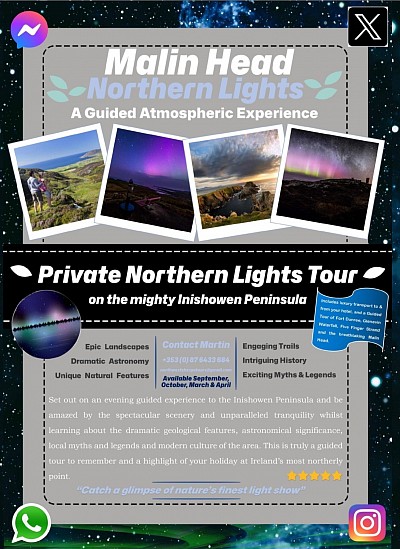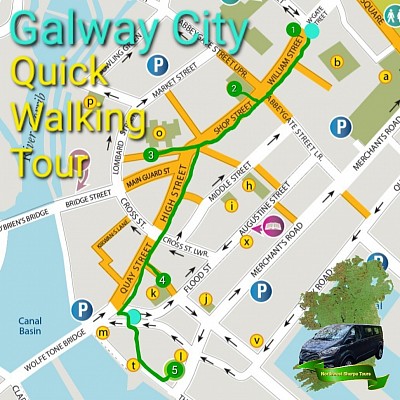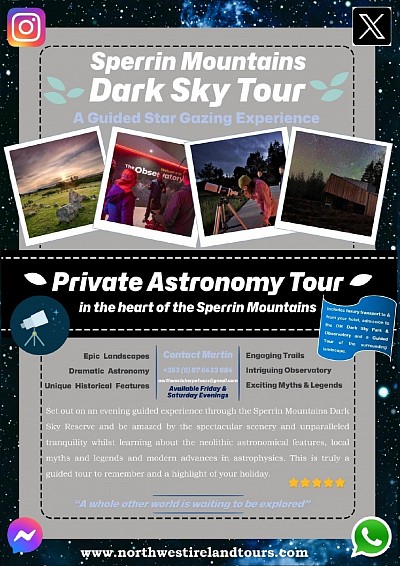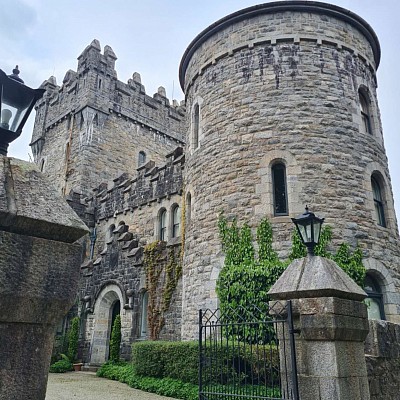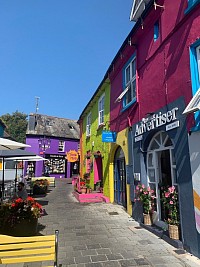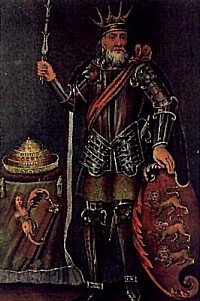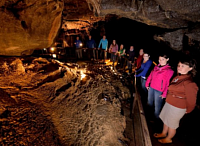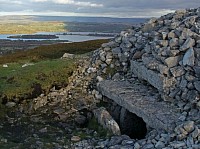Sherpa Travel Blog
Ireland's Northern Lights Experience
"Enjoy a Private Tour to Remember!"
Since we're coming around to aurora borealis season and I'm chomping at the bit to see more of nature's finest light show, the Northern Lights Evening Tour has been crafted to suit guests looking for a unique Irish experience that will leave you contemplating the cosmos on the spectacular Inishowen Peninsula, Ireland's most northerly point. Set out on an evening guided experience and be amazed by the breathtaking scenery and unparalleled tranquility whilst learning about the dramatic geological features, astronomical significance, local myths and legends and modern culture of the area. This is truly a guided tour to remember and a highlight of your holiday. Feel free to get in touch for more details.
BOOK or ENQUIRE
Galway City: Quick Self-Guided Walking Tour
Should you find yourself with only an hour to spare in the fabulous city of Galway, don't despair, for you can actually see quite a lot. Thanks to it's narrow streets and condensed city centre, there are many spectacular attractions just a stones throw away from each other. Here's my list of the top five, conveniently located along a straight drag encompassing William Street, Shop Street, High Street and Quay Street.
1. At the top of William Street is an excellent place to start your turbo tour. There, you'll first find the Statue of Oscar Wilde and Eduard Vilde.
Oscar Wilde (1854-1900) was an Irish poet, playwright, and novelist, famous for his witty works such as The Importance of Being Earnest and The Picture of Dorian Gray. He was also a controversial figure in his time, due to his homosexuality and imprisonment for gross indecency.
Eduard Vilde (1856-1933) was an Estonian journalist, critic, and novelist, considered one of the founders of Estonian literature. He wrote realistic novels that depicted the social and political issues of his era, such as The War of Mahtra and The Milkman of Verona. He was also a diplomat and a supporter of Estonian independence.
The two men never met in real life, but they have a lot in common. They both lived in the late 19th and early 20th centuries, they both wrote in different genres and languages, and they both faced censorship and persecution for their views. They also both visited Paris, where they died and are buried.
2. Continue down to the corner of Shop Street and Abbeygate Street Upper where you'll find Lynch Castle.
This Castle, which now houses the AIB bank, could easily go unnoticed. Yet it is a striking example of a medieval fortified house. The castle is four storeys high with embellished carved windows, gargoyles and ornamental mouldings and cornices. Built by the powerful Lynch family as a protection from raids, parts of the limestone building may date back to the 14th century but the bulk of it was built in the 16th century. The Lynches, of Anglo-Norman descent, were one of the powerful 14 tribes who ruled Galway.
Have you ever wondered where the term “lynching” comes from? The Lynch family supplied Galway with over 80 majors between the 15th and 17th centuries. One of those mayors was a fellow named James Lynch. James Lynch had a son named Walter who was a bit of a hothead and the story goes that in 1493, Walter murdered a young Spaniard over something to do with a woman.
Well, in addition to being the major of Galway, James Lynch was also the magistrate, and determined to seek justice for the murdered Spaniard, he convicted his own son and sentenced him to death. On the fateful morning on which Walter Lynch was to be hung, the Mayor and bailiffs tried to escort him to the gallows. But a large crowd, sympathetic to the young man, had formed to prevent the hanging. So the Mayor, still holding his bound son, took him into their house nearby and on reaching an upper window overlooking the street, he fastened a rope around his son’s neck and launched him from the window, hanging him in full view of the “Lynch mob” assembled below. And so the term “lynching,” was coined in this castle on this street.
3. St. Nicholas Collegiate Church is next on the list, on Churchyard Lane, just off High Street.
Founded by the Normans in the early 1200s. When the church was first founded, Galway was a tiny, very new town, a sort of frontier settlement in the wild west of Ireland. Visitors to St Nicholas' over the centuries are said to have included Christopher Columbus, believed to have prayed there on a visit to Galway in 1477, and, somewhat less welcome - Cromwellian troops who used the church as a stables for their horses after the siege of Galway in 1652. They are blamed for the headless state of most of the carved figures inside the church.
4. Hang a left off Quay Street and onto Druid Lane, where you'll find the impressive ruins of the Hall of the Red Earl.
This great hall is a fascinating medieval archaeological site in the heart of Galway. It dates to the 13th century and is linked to the founding of Galway by the Anglo-Norman De Burgo family at this time. The hall was Galway’s first municipal building and was used to collect taxes, dispense justice and to host banquets. In essence it acted as a tax office, courthouse and town hall rolled into one! It took its name from Richard de Burgo, the Earl of Ulster, who was the grandson of the town’s founding father.
In the late 15th century the famous ‘Tribe’ families of Galway seized power from the De Burgos and forced them out of the city. The hall subsequently became abandoned and fell into ruin. Over the intervening centuries it was covered over and built upon. The remains of the building were, however, unearthed by Office of Public Works (OPW) archaeologists in 1997.
5. Finally, once you reach the bottom of Quay Street, cast your eye to the waterfront on the left where you’ll see the famous Spanish Arch.
The Spanish Arch was built in 1584 but is an extension of the 12th century Norman-built town wall. It housed soldiers who kept watch and manned cannons on the roof. It became known as the Spanish Arch in reference to the former merchant trade with Spain and Spanish galleons, which often docked here. In medieval times, European ships carrying cargo of wine and spices sold their goods at the docks. In fact, Christopher Columbus visited in 1477. In 1755, The Spanish Arch was partially destroyed by a tsunami. In the 1800s, the Eyre family added the Long Walk extension. Until 2006, The Spanish Arch housed the Galway City Museum, which has now moved to a new location 50 yards away behind the original museum building.
That's my list of the best five sites to visit if you've an hour to spare in Galway. Better yet, why not book a guided tour of Ireland's north and west, where I'll tell you all about the myths, culture, folklore and scandals of each area. Ireland is a playground for the creatively minded and waiting to be explored.
New Stargazing Evening Tour
Due to popular demand and my own personal interest in astronomy, I've crafted a bespoke evening experience that will leave you comtemplating the cosmos in the spectacular surroundings of the Sperrin Mountains. Venture out on a guided experience through County Tyrone's Dark Sky Reserve and be amazed by the spectacular scenery and unparalleled tranquility whilst learning about the neolithic astronomical features, local myths and legends and modern advances in astrophysics. This tour includes a visit to boggy mountains, vast woodland, stone circles and a tour around the OM Dark Sky Reserve. Departing from Letterkenny, Derry, Strabane or Dungiven, this is truly a guided tour to remember and a highlight of your holiday. Feel free to get in touch for more details.
The Dark History of the Iconic Glenveagh Castle
Considering the majestic Glenveagh Castle displays a vibrant interior, showcases unparalleled beauty in its exotic gardens and is situated in one of the most spectacular mountain ranges in Ireland, its story is a dark one at best. Its original owner, the dreaded ‘Black Jack’ Adair immediately after the Great Famine and at a time of mass emigration, evicted 224 tenants from his ‘blackhouses’ on his 28,000 acres of land. This was not for any financial gain, but merely to improve the aesthetic from his baronial style castle. These tenant clearances became known as the "Derryveagh Evictions". Most of the tenants perished shortly after with just a handful surviving to tell the tale. The cruel deeds of Captain John George Adair have passed into history and folklore, ballad and documentary.
However, there is another dark twist to this castle’s past which often gets overlooked and it is that of the following owner, the internationally renowned Harvard University professor Arthur Kingsley Porter who purchased this magnificent manor and the surrounding property from the Adair estate in 1929. Porter and his wife Lucy fell in love with County Donegal, and quite frankly, who can blame them. They used the premises as a second home, to display his significant art collection, and to entertain guests. Porter was a man of nature and not entirely comfortable with the grandeur of Glenveagh Castle. He also built a fishing cottage on the nearby Inishbofin Island where he enjoyed its solitude. Arthur was troubled though and suffered bouts of depression. Lucy, his faithful wife, was willing to do whatever she could to help him, and when his psychiatrist suggested that he take a male Italian companion to live with them, she agreed. After this, it has been noted that his spirits did lift some. Meanwhile, across the pond Harvard was busy purging its faculty of homosexuality and Porter feared for his career, publications and reputation. This caused him great angst and the couple spent more time in the cottage on Inishbofin where life just seemed simpler.
However, on the 8th of July 1933, Arthur and his wife were walking along the island’s coastline before dinner. Lucy said that she must head back and prepare for the arrival of guests. Arthur said he’d continue walking a little and meet her back there. Sadly, he never did. He disappeared that day with the consensus being that he slipped and fell off a section of cliffs. The speculation turned to suicide, although at the inquest, Porter's widow insisted that he was not of that mind frame. Further conspiracies note Lucy’s lack of emotion at the inquest and observe her frequent visits to Italy in the years that follow. Is it possible that she helped her husband stage his own death and go into hiding in the Mediterranean? Others have implied that, tired of his lifestyle, Lucy herself pushed him off the cliffs, although evidence from her diaries gave no indication that this was something she’d ever contemplated. Alas, it’s more likely that the inquest’s conclusion was the correct one. So many lives have been taken along the Donegal coastline inexplicably. In fact, it’s in this very county that the belief in selkies (people near or in the water turning into seals) emerged as a way to give closure to the families of those lost at sea. Afterwards, Lucy sold the castle and properties to Henry Plumer McIlhenny of Philadelphia. He was a friend and former student of Porter's at Harvard University, who had ancestry in the county.
These dark tales of Glenveagh Castle stand in contrast to its incredible beauty. The Derryveagh Mountains possess an iconic sense of marvel and wonder, from the pristine waters of its rivers and lakes, to the pockets of sissile oak filled temperate rainforest dotted with explosions of ferns and greater wood rushes, to the shimmering quartzite mountain peaks where sheep and deer roam in harmony. To even begin to get a sense of the lifestyles, trials and tribulations of the past occupants of this sparse countryside, one really needs to stand along the lakeshore and view the surroundings in all their splendour.
A must read book about Ireland... “Hell or Some Worse Place: Kinsale 1601” Des Ekin
If ever there were a story which deserved adaptation to the silver screen, the tale of the siege of Kinsale would be top of my list. This is owed in part to the complexity of the events, the big name historical characters of Ireland, Britain and Spain, and the implications this battle had on the structure of power in Europe both politically and religiously. The manner in which this awesome incursion is portrayed by author Des Ekin amplifies the sense of significance the clash of the two European titans had on our present day. He continually cuts back from the dark days of the siege to the religiopolitical events leading to its occurrence. While reading this account, I was right there alongside the Spanish soldiers within the town walls. Ekin’s descriptive style allowed me to conjure up in my mind the inhospitable and almost apocalyptic conditions these troops were living in. His harsh but exhilarating account of the doomed plight of the Gaelic reinforcements such as the armies of the O’Donnells, O’Neills and O’Sullivans brought home the sharp reality that this battle was a major contributing factor in the final subjugation of the entire island by the British. As I regularly roam the colourful streets of Kinsale today with the many vibrant craft shops and boutique restaurants, this book has elevated ordinary looking old stone buildings to relics of pivotal moments in Irish and European history in my mind.
Most intriguing Irish historical character? Brian Boru
Did you ever think about the history of your country and imagine what it would be like today, had a single event unfolded differently long ago? As a guide, I find myself retelling so many Irish historical moments and asking myself this question. Had the great Gaelic chieftain, considered by many as the high king of Ireland around the turn of the first millennium, not defeated the Vikings in Dublin, Ireland, I imagine, would look extremely different today. Our architecture may be more Scandinavian in its design. We may have far fewer redheads and many more blondes. We may even be speaking some variant of Old Norse had they went on to repel the Norman invasion in the next century. It would be interesting, but I’m sure glad it didn’t work out like that. I’m certain that these thoughts never crossed Brian’s mind as he left the battlefield having ended Viking dominance on the island. He may however, have questioned the serendipity of the many events which led the youngest of twelve brothers to inherit the crown. His life story is one that never fails to blow my mind and provoke existential thought. As you travel right around Ireland, you feel his legacy; in the many castles you enter, at the battle sites you pass and on the faces of any O’Brien you meet.
Favourite main natural attraction in northwest Ireland? Marble Arch Caves, Co. Fermanagh
When I first heard about the most active river cave in Ireland, I figured it was just a catchy slogan like the highest bar in Belfast or the most westerly waterfall in Waterford. It took a trip with my family one summer to discover just how otherworldly this Marble Arch Caves really are. As the guide rowed us down the subterranean river on a small boat into the labyrinth caves, I couldn't help but feel a little bit like Indiana Jones on some dramatic adventure. Set in the picturesque foothills of Cuilcagh Mountain, this experience is the perfect example of what to expect in Ireland when you venture off the beaten path just a little. The dimly lit caves were brought to life by the fascinating stories of their discovery, told by a local guide who was passionate and extremely proud of her area.
Favourite hidden gem in northwest Ireland? Carrowkeel Passage Tombs
Location, scenery and seclusion are what make the Carrowkeel Passage Tombs my number one hidden gem in Ireland. Nestled at the top of the Bricklieve Mountains, anyone who ventures up here can enjoy epic views of counties Donegal, Sligo, Leitrim, Roscommon and Mayo. Like the other passage tombs in Ireland such as the mighty Newgrange in County Meath, these tombs are between 5000 and 5500 years old. The striking difference however, is the fact that you can wander into these cruciform shaped tombs by yourself and dwell on the timeline without the crowds of people you’ll see elsewhere. When I last took the short hike to reach these tombs on an unseasonably warm Spring Equinox afternoon, I got the sense that I'd worked to earn the experience. As I munched on sandwiches and sipped tea from my flask at the top, I thought about the task of hauling the huge boulders up this mountain. The rugged beauty of that landscape made it easier to imagine what life may have been like for the Neolithic people who once lived there.
